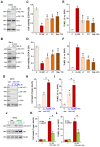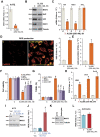The therapeutic value of XL388 in human glioma cells
- PMID: 33159013
- PMCID: PMC7746352
- DOI: 10.18632/aging.103791
The therapeutic value of XL388 in human glioma cells
Abstract
XL388 is a highly efficient and orally-available ATP-competitive PI3K-mTOR dual inhibitor. Its activity against glioma cells was studied here. In established and primary human glioma cells, XL388 potently inhibited cell survival and proliferation as well as cell migration, invasion and cell cycle progression. The dual inhibitor induced significant apoptosis activation in glioma cells. In A172 cells and primary human glioma cells, XL388 inhibited Akt-mTORC1/2 activation by blocking phosphorylation of Akt and S6K1. XL388-induced glioma cell death was only partially attenuated by a constitutively-active mutant Akt1. Furthermore, it was cytotoxic against Akt1-knockout A172 glioma cells. XL388 downregulated MAF bZIP transcription factor G (MAFG) and inhibited Nrf2 signaling, causing oxidative injury in glioma cells. Conversely, antioxidants, n-acetylcysteine, pyrrolidine dithiocarbamate and AGI-106, alleviated XL388-induced cytotoxicity and apoptosis in glioma cells. Oral administration of XL388 inhibited subcutaneous A172 xenograft growth in severe combined immunodeficient mice. Akt-S6K1 inhibition and MAFG downregulation were detected in XL388-treated A172 xenograft tissues. Collectively, XL388 efficiently inhibits human glioma cell growth, through Akt-mTOR-dependent and -independent mechanisms.
Keywords: Akt; MAFG; XL388; glioma; mTOR.
Conflict of interest statement
Figures





Similar articles
-
The anti-cancer activity of the mTORC1/2 dual inhibitor XL388 in preclinical osteosarcoma models.Oncotarget. 2016 Aug 2;7(31):49527-49538. doi: 10.18632/oncotarget.10389. Oncotarget. 2016. PMID: 27385099 Free PMC article.
-
The preclinical assessment of XL388, a mTOR kinase inhibitor, as a promising anti-renal cell carcinoma agent.Oncotarget. 2017 May 2;8(18):30151-30161. doi: 10.18632/oncotarget.15620. Oncotarget. 2017. PMID: 28404914 Free PMC article.
-
NVP-BEZ235, a novel dual PI3K-mTOR inhibitor displays anti-glioma activity and reduces chemoresistance to temozolomide in human glioma cells.Cancer Lett. 2015 Oct 10;367(1):58-68. doi: 10.1016/j.canlet.2015.07.007. Epub 2015 Jul 15. Cancer Lett. 2015. PMID: 26188279
-
FK228 augmented temozolomide sensitivity in human glioma cells by blocking PI3K/AKT/mTOR signal pathways.Biomed Pharmacother. 2016 Dec;84:462-469. doi: 10.1016/j.biopha.2016.09.051. Epub 2016 Sep 28. Biomed Pharmacother. 2016. PMID: 27685789
-
AS1411-Induced Growth Inhibition of Glioma Cells by Up-Regulation of p53 and Down-Regulation of Bcl-2 and Akt1 via Nucleolin.PLoS One. 2016 Dec 1;11(12):e0167094. doi: 10.1371/journal.pone.0167094. eCollection 2016. PLoS One. 2016. PMID: 27907160 Free PMC article.
Cited by
-
The role and regulation of Maf proteins in cancer.Biomark Res. 2023 Feb 7;11(1):17. doi: 10.1186/s40364-023-00457-w. Biomark Res. 2023. PMID: 36750911 Free PMC article. Review.
-
Molecular Mechanisms and Clinical Challenges of Glioma Invasion.Brain Sci. 2022 Feb 20;12(2):291. doi: 10.3390/brainsci12020291. Brain Sci. 2022. PMID: 35204054 Free PMC article. Review.
-
The effects of hepatocyte-specific MafF overexpression on FFA or ETOH induced hepatocyte steatosis and its underlying mechanism.Hepatol Forum. 2025 Apr 30;6(3):91-98. doi: 10.14744/hf.2024.2024.0030. eCollection 2025. Hepatol Forum. 2025. PMID: 40686592 Free PMC article.
-
Aberrant Expression of ADARB1 Facilitates Temozolomide Chemoresistance and Immune Infiltration in Glioblastoma.Front Pharmacol. 2022 Feb 1;13:768743. doi: 10.3389/fphar.2022.768743. eCollection 2022. Front Pharmacol. 2022. PMID: 35177985 Free PMC article.
References
Publication types
MeSH terms
Substances
LinkOut - more resources
Full Text Sources
Medical
Miscellaneous

